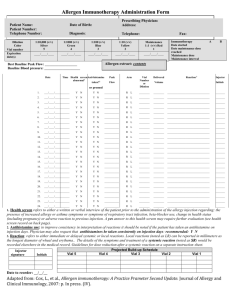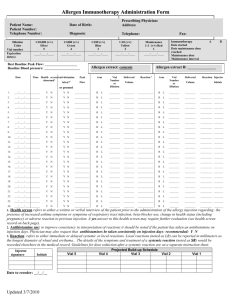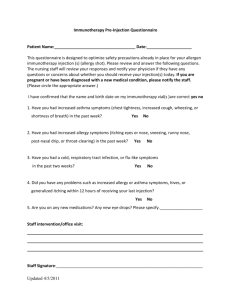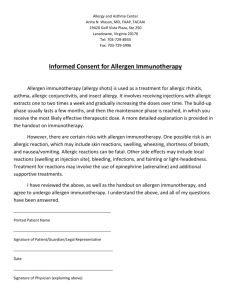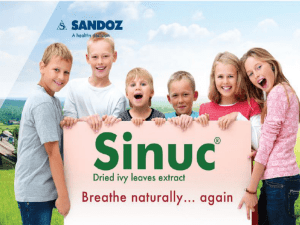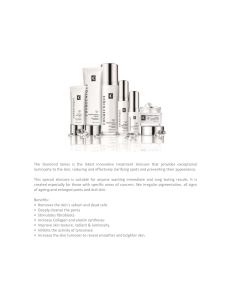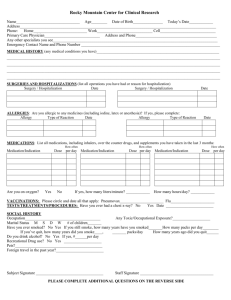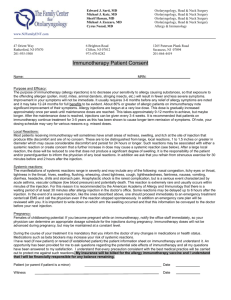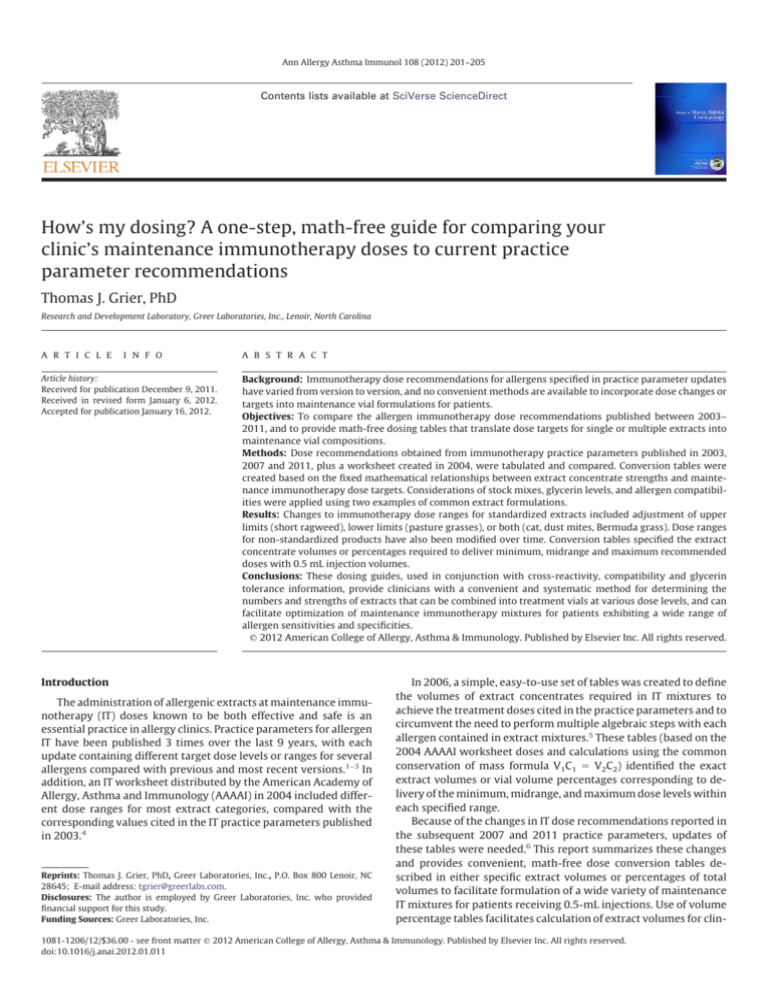
Ann Allergy Asthma Immunol 108 (2012) 201–205
Contents lists available at SciVerse ScienceDirect
How’s my dosing? A one-step, math-free guide for comparing your
clinic’s maintenance immunotherapy doses to current practice
parameter recommendations
Thomas J. Grier, PhD
Research and Development Laboratory, Greer Laboratories, Inc., Lenoir, North Carolina
A R T I C L E
I N F O
Article history:
Received for publication December 9, 2011.
Received in revised form January 6, 2012.
Accepted for publication January 16, 2012.
A B S T R A C T
Background: Immunotherapy dose recommendations for allergens specified in practice parameter updates
have varied from version to version, and no convenient methods are available to incorporate dose changes or
targets into maintenance vial formulations for patients.
Objectives: To compare the allergen immunotherapy dose recommendations published between 2003–
2011, and to provide math-free dosing tables that translate dose targets for single or multiple extracts into
maintenance vial compositions.
Methods: Dose recommendations obtained from immunotherapy practice parameters published in 2003,
2007 and 2011, plus a worksheet created in 2004, were tabulated and compared. Conversion tables were
created based on the fixed mathematical relationships between extract concentrate strengths and maintenance immunotherapy dose targets. Considerations of stock mixes, glycerin levels, and allergen compatibilities were applied using two examples of common extract formulations.
Results: Changes to immunotherapy dose ranges for standardized extracts included adjustment of upper
limits (short ragweed), lower limits (pasture grasses), or both (cat, dust mites, Bermuda grass). Dose ranges
for non-standardized products have also been modified over time. Conversion tables specified the extract
concentrate volumes or percentages required to deliver minimum, midrange and maximum recommended
doses with 0.5 mL injection volumes.
Conclusions: These dosing guides, used in conjunction with cross-reactivity, compatibility and glycerin
tolerance information, provide clinicians with a convenient and systematic method for determining the
numbers and strengths of extracts that can be combined into treatment vials at various dose levels, and can
facilitate optimization of maintenance immunotherapy mixtures for patients exhibiting a wide range of
allergen sensitivities and specificities.
䉷 2012 American College of Allergy, Asthma & Immunology. Published by Elsevier Inc. All rights reserved.
Introduction
The administration of allergenic extracts at maintenance immunotherapy (IT) doses known to be both effective and safe is an
essential practice in allergy clinics. Practice parameters for allergen
IT have been published 3 times over the last 9 years, with each
update containing different target dose levels or ranges for several
allergens compared with previous and most recent versions.1–3 In
addition, an IT worksheet distributed by the American Academy of
Allergy, Asthma and Immunology (AAAAI) in 2004 included different dose ranges for most extract categories, compared with the
corresponding values cited in the IT practice parameters published
in 2003.4
Reprints: Thomas J. Grier, PhD, Greer Laboratories, Inc., P.O. Box 800 Lenoir, NC
28645; E-mail address: tgrier@greerlabs.com.
Disclosures: The author is employed by Greer Laboratories, Inc. who provided
financial support for this study.
Funding Sources: Greer Laboratories, Inc.
In 2006, a simple, easy-to-use set of tables was created to define
the volumes of extract concentrates required in IT mixtures to
achieve the treatment doses cited in the practice parameters and to
circumvent the need to perform multiple algebraic steps with each
allergen contained in extract mixtures.5 These tables (based on the
2004 AAAAI worksheet doses and calculations using the common
conservation of mass formula V1C1 ⫽ V2C2) identified the exact
extract volumes or vial volume percentages corresponding to delivery of the minimum, midrange, and maximum dose levels within
each specified range.
Because of the changes in IT dose recommendations reported in
the subsequent 2007 and 2011 practice parameters, updates of
these tables were needed.6 This report summarizes these changes
and provides convenient, math-free dose conversion tables described in either specific extract volumes or percentages of total
volumes to facilitate formulation of a wide variety of maintenance
IT mixtures for patients receiving 0.5-mL injections. Use of volume
percentage tables facilitates calculation of extract volumes for clin-
1081-1206/12/$36.00 - see front matter 䉷 2012 American College of Allergy, Asthma & Immunology. Published by Elsevier Inc. All rights reserved.
doi:10.1016/j.anai.2012.01.011
202
Thomas J. Grier / Ann Allergy Asthma Immunol 108 (2012) 201–205
Table 1
Maintenance IT dose targets for standardized extracts reported in IT Practice Parameters and AAAAI Worksheet from 2003–2011
Extract category
Short ragweed
Cat
Dust mites
Pasture grassesc
Bermuda grass
Pollen
Fungi
Insects, animals
Dog AP
Target IT doses or ranges
2003
2004
2007
2011
6–24 AgE U (g)
1:30–1:100 w/v
2,000–3,000 BAU
600 AUa or 2,000 AUb
4,000 BAU
Not specified
1:30–1:100 w/v
1:50–1:100 w/v
Not specified
Not specified
6–12 AgE U (g)
1:50–1:250 w/v
2,000–3,000 BAU
500–2,000 AU
1,000–4,000 BAU
Not specified
1:50–1:250 w/v
1:50–1:250 w/v
Not specified
Not specified
6–12 AgE U (g)
6–12 AgE U (g)
1,000–4,000 BAU
500–2,000 AU
1,000–4,000 BAU
Not specified
HTD
HTD
HTD
15 g Can f 1
1,000–4,000 BAU
500–2,000 AU
1,000–4,000 BAU
300–1,500 BAU
1:100–1:200 w/v
HTD
HTD
15 g Can f 1
Abbreviations: w/v, weight-to-volume ratio; AgE, Antigen E or Amb a 1; U, Unit; AU, Allergy Unit; BAU, Bioequivalent Allergy Unit; HTD, highest tolerated dose.
Changes from the previous publication are illustrated in bold type.
a
D. pteronyssinus.
b
D. farinae.
c
Kentucky Blue/June, Meadow Fescue, Orchard, Perennial Rye, Redtop, Sweet Vernal, Timothy.
ics that formulate IT prescription vials at final volumes other than
5.0 mL and simplifies calculation of final glycerin concentrations in
these mixtures. Revisions of these tables are required if injection
volumes other than 0.5 mL are employed.
Methods
Recommended IT dose ranges
Maintenance IT dose ranges for licensed standardized and nonstandardized allergenic extracts manufactured in the United States
were obtained from the 2004 AAAAI Immunotherapy Prescription
Worksheet and the 2003, 2007, and 2011 IT practice parameter
updates.1– 4 All doses described in these documents were based on
a 0.5-mL injection volume. Nonstandardized extract dose targets
were described in w/v terms for all extract types and concentrate
strengths. Doses in protein nitrogen unit (PNU) strengths were not
reported. Standardized short ragweed extracts were initially reported in both w/v and Amb a 1 (Antigen E, or AgE) units, and
standardized Bermuda grass extracts were not included until the
2011 update. Selection of an appropriate dose range for Bermuda
grass was complicated by the standardization of this product in a
less sensitive study population than the 7 northern pasture
grasses.3 For patients displaying comparable Bermuda and pasture
grass sensitivities, doses proportional to their concentrate
strengths were advised.5
0.5 mL of a 4,000 BAU/mL solution is required. These values can be
revised easily to address any desired IT vial volume–injection volume combination.
The volumes or percentages listed on the various conversion
tables were calculated using either the conservation of mass formula V1C1 ⫽ V2C2 (V1 and C1 represent the initial volume and
extract concentration, V2 and C2 the final values in the extract
mixture), or dilution factors and fractional volumes relative to
extract concentrates. Using the formula with a target dust mite
extract dose of 2,000 AU, the formula becomes V1 ⫻ 10,000 AU/mL ⫽
5.0 mL ⫻ 4,000 AU/mL, or V1 ⫽ 2.0 mL. Using the dilution factor
approach, a 2.5-fold dilution of 10,000 AU/mL dust mite extract is
required to prepare a 4,000 AU/mL solution, thus, 2.0 mL of this
extract into a 5.0 mL final vial volume or 40% of the final formulation. (2.0 mL/5.0 mL ⫻ 100).
Extract volumes and percentages were determined in this manner for extract doses at their lower limits (designated as Min in the
tables), upper limits (Max), and mid-range values (Mid), and tabulated separately for formulations utilizing 5.0 mL or variable IT vial
volumes.
Human subject participation was not required to perform
these extract dose calculations; thus, this study was exempt
from review by an institutional board or human subjects protection committee.
Calculation of extract volumes and percentages
Results
To calculate the volumes or percentages of each extract required
to deliver specific maintenance IT doses, 3 variables must be defined: the total volume of the maintenance vial, the final extract
concentrations in these vials, and the injection volumes. The practice parameter recommendations assume a 0.5 mL injection volume for both nonstandardized extracts in w/v strengths and standardized extracts in specific product units per milliliter, but lower
(0.2– 0.3 mL) and higher (0.7–1.0 mL) volumes are also used in
some clinics. The initial dose tables from this author included data
for 0.2-mL and 0.3-mL injections.5 In addition, although 5.0 mL vial
volumes are commonly used in many clinics, some prefer lower
(1.0 –2.0 mL) or higher (6.0 –10.0 mL) final volume formulations to
meet the needs of their practice. The calculations in this report are
based on the 2011 IT practice parameter dose ranges, 0.5 mL injection volumes, and either 5.0 mL or variable vial volumes to accommodate a wide variety of practice preferences. Adoption of a 0.5-mL
injection volume facilitates dosing calculations for standardized
products, in that the final concentration of each extract in a mixture
is simply twice the numerical value of the final dose. For example,
to administer 2,000 bioequivalent allergy units (BAU) of cat extract,
Chronology of IT practice parameter dose recommendations
Maintenance IT doses published in the 2004 AAAAI IT worksheet
and the 2003, 2007, and 2011 IT practice parameters are summarized in Tables 1 and 2. Changes from the previous publication are
illustrated in bold type. The IT doses for standardized extracts were
mostly consistent across the various updates (Table 1). The changes
observed for these products included a reduced upper limit (short
ragweed), reduced lower limit (pasture grasses), reduced lower
plus increased upper limits (cat), and clarification of dose ranges for
specific products (dust mite Dermatophagoides species). Bermuda
grass doses were first reported in 2011 to differentiate IT recommendations for this subtropical species from those of the temperate pasture grasses. Nonstandardized extract dose recommendations were also modified across these documents (Table 1). Dose
ranges were expanded and then narrowed (pollen), specified generically as the highest tolerated dose (HTD: fungi, insects), and
reported at 1 dose based on a single study with an acetone-precipitated (AP) dog hair-dander extract.1–3
Thomas J. Grier / Ann Allergy Asthma Immunol 108 (2012) 201–205
203
Table 2
Extract volumes needed for 5.0 mL maintenance vials with 0.5 mL injection volume at minimum (min), mid-range (mid), and maximum (max) dose targets from 2011 IT
Practice Parameters
Extract/concentrate strength
Volume of concentrate needed per vial (mL)
Category
Concentrate
Min
Mid
Max
Pollens, fungi, insects
1:10 w/v
1:20 w/v
1:40 w/v
200 AgE U/mL
10,000 BAU/mL
1:100 w/v
1:10 w/v
1:20 w/v
30,000 AU/mL
10,000 AU/mL
100,000 BAU/mL
10,000 BAU/mL
10,000 BAU/mL
0.25
0.50
1.00
0.30
1.00
NA
0.25
0.50
0.17
0.50
0.10
1.00
0.30
0.375
0.75
1.50
0.45
2.50
NA
0.375
0.75
0.42
1.25
0.25
2.50
0.90
0.50
1.00
2.00
0.60
4.00
1.00
0.50
1.00
0.67
2.00
0.40
4.00
1.50
Short ragweeda
Cat
Dog AP
Dog epithelia
Dust mitesb
Pasture grassesb
Bermuda grass
Abbreviations: w/v, weight-to-volume ratio; AgE, Antigen E or Amb a 1; U, Unit; AU, Allergy Unit; BAU, Bioequivalent Allergy Unit; NA, Not applicable.
Minimum recommended dose was not specified for this extract category.
a
Also applies to ragweed mix (short ⫹ giant) products at 1:20 w/v and approx. 100 AgE U/mL.
b
Also applies to dust mite mix and pasture grass mix (eg, KORT, 7 grass) products at the same AU/mL or BAU/mL strengths.
IT formulation tables
Using the fixed mathematical relationships between extract
concentrate strengths and final concentrations needed to deliver
specific target doses, the volumes of extract concentrates to be
added to 5.0 mL maintenance IT vials (or the percentages of these
extracts in IT vials containing 5.0 mL or variable volumes) were
determined to facilitate a convenient conversion of the 2011 IT
practice parameter dose ranges for practical use, with no additional
steps or repetitious calculations required. Extract concentrate volumes needed to deliver minimum, mid-range, and maximum doses
are summarized in Table 2. These data expressed as percentages of
the final vial volumes are shown in Table 3. The target dose range of
1:100 to 1:200 w/v for nonstandardized pollen extracts was also
employed for fungal and insect extracts specified as HTD in the
practice parameters, and for dog epithelia extracts that possess a
different qualitative allergen profile compared with dog AP.7 For
patients or geographic regions in which these doses are tolerated
poorly, suitable reductions of these volumes or percentages, or use
of similar volumes of the previous vial strength (10-fold dilution of
maintenance concentrate), should be considered.
Using the Min, Mid, or Max columns of each table, the numbers
and types of extracts that can be combined into IT vaccines are
determined by adding the volumes or percentages from the col-
umns corresponding to the desired doses, up to the total vial contents (5.0 mL or 100%, respectively). For example, maintenance
vials can contain up to ten 1:10 w/v extracts at maximum doses, or
up to ten 1:20 w/v products at minimum doses (0.5 mL each or 10%
of total volume).
Cross-reactive allergens contribute additive doses for many patients. Selection of extract mixtures within well-defined homologous groups may be preferred in some cases compared with singlespecies products from these groups.8 –11 When stock mixes
containing extracts from the same genus (ragweed mix, dust mite
mix) or same tribe (pasture grass mixes) are used in place of a
single-species representative, equivalent volumes and target doses
are recommended (as noted in Tables 2 and 3).
When using stock mixes of unrelated or non– cross-reactive
extracts, however, the allergen potencies are not additive but individualized and represent only a fraction of the total or labeled
extract strength for these products. For example, a regional pollen
mix composed of 6 unrelated tree species at a labeled (total)
strength of 1:20 w/v actually contains each allergen at a final
strength of 1:120 w/v. Volumes of these mixes added to IT prescriptions may need to be increased accordingly to achieve therapeutic
doses. In some clinics, mixes such as these are used as maintenance
IT concentrates without further extract additions or dilution.
Table 3
Extract volume percentages needed for 5.0 mL or variable volume maintenance vials with 0.5 mL injection volume at minimum (min), mid-range (mid), and maximum
(max) dose targets from 2011 IT Practice Parameters
Extract/concentrate strength
% of Total vial volume
Category
Concentrate
Min
Mid
Max
Pollens, fungi, insects
1:10 w/v
1:20 w/v
1:40 w/v
200 AgE U/mL
10,000 BAU/mL
1:100 w/v
1:10 w/v
1:20 w/v
30,000 AU/mL
10,000 AU/mL
100,000 BAU/mL
10,000 BAU/mL
10,000 BAU/mL
5
10
20
6
20
NA
5
10
3.4
10
2
20
6
7.5
15
30
9
50
NA
7.5
15
8.4
25
5
50
18
10
20
40
12
80
20
10
20
13.4
40
8
80
30
Short ragweeda
Cat
Dog AP
Dog epithelia
Dust mitesb
Pasture grassesb
Bermuda grass
Abbreviations: w/v, weight-to-volume ratio; AgE, Antigen E or Amb a 1; U, Unit; AU, Allergy Unit; BAU, Bioequivalent Allergy Unit; NA, not applicable.
Minimum recommended dose was not specified for this extract category.
a
Also applies to Ragweed mix (short ⫹ giant) products at 1:20 w/v and approx. 100 AgE U/mL.
b
Also applies to dust mite mix and pasture grass mix (eg, KORT, 7 grass) products at the same AU/mL or BAU/mL strengths.
204
Thomas J. Grier / Ann Allergy Asthma Immunol 108 (2012) 201–205
Table 4
Extract and glycerin content of 5.0 mL maintenance vial of example 1 IT mixture at minimum (min), mid-range (mid), and maximum (max) dose targets
Extract
Concentrate
Min (mL)
Mid (mL)
Max (mL)
Cottonwood
Elm
Maple
Oak
Pigweed
Lamb’s quarter
Short ragweed
Timothy
Total allergen volume
Aqueous diluent volume needed
Glycerinated allergen volume
Final glycerin concentration
1:10 w/v, aqueous
1:10 w/v, aqueous
1:10 w/v, aqueous
1:10 w/v, aqueous
1:10 w/v, aqueous
1:20 w/v, 50% glycerin
200 AgE U/mL, 50% glycerin
100,000 BAU/mL, 50% glycerin
0.25
0.25
0.25
0.25
0.25
0.50
0.30
0.10
2.15
2.85
0.90
9.0%
0.375
0.375
0.375
0.375
0.375
0.75
0.45
0.25
3.325
1.675
1.45
14.5%
0.50
0.50
0.50
0.50
0.50
1.00
0.60
0.40
4.50
0.50
2.00
20.0%
Abbreviations: w/v, weight-to-volume ratio; AgE, Antigen E or Amb a 1; U, Unit; BAU, Bioequivalent Allergy Unit.
The final glycerin concentration of IT mixtures (in percentage)
can be determined easily using either table. When using Table 2,
add the volumes of all products supplied in 50% glycerin, then
multiply by 10 (and add %). When using Table 3, add the percentages for all glycerinated items, then divide by 2. Glycerin levels
above 20 to 25% may be difficult to tolerate for some patients; thus,
monitoring the component and final glycerin levels in these mixtures is important to minimize pain or local reactions and promote
adherence to treatment.12
Discussion
The establishment of appropriate dose ranges in IT mixtures
remains a clinic-specific activity for many allergists in diverse geographic regions across the United States, owing in part to differences in exposures to provocative allergens and variable patient
sensitivities to these allergens. Treatment guidelines contained in
IT practice parameter updates include the quantities of standardized and nonstandardized extracts likely to produce successful
therapeutic outcomes with most patients.1–3 Recognizing that
these maintenance dose recommendations are derived from studies performed with both US and European extracts, and, in some
cases, may not represent clinically relevant IT doses for certain
allergic patients, is important.3,13 The appropriateness of these
dosing guidelines with alum-precipitated depot extracts, when
used in place of aqueous or glycerinated formulations of the same
allergenic products, is also uncertain, and identification of effective
IT doses and maintenance vial formulations for patients remains an
individualized process.3 The objective of this report is to provide a
precise conversion of 2011 IT practice parameter dose recommendations into practical extract volumes or vial percentages that can
simplify calculations or facilitate mixing procedures in clinical settings. The data contained in this report apply strictly to the 2011
practice parameters, and, as inferred, are not necessarily applicable
to all IT formulations and treatment regimens.
Comparisons of the maintenance doses used in allergy clinics
with those reported in the practice parameters require several
algebraic steps and a concentration-to-dose conversion based on
the volume of injected vaccine. Multiple calculations are typically
required to account for differences in injection volumes, extract
concentrate strengths, or allergen mix formulations within a single
or group practice.
The conversion tables provided in this summary were created to
eliminate the need for clinicians or mixing technicians to perform
these repetitious mathematical computations. Using these tables
alone (no additional calculations required), allergy professionals
can quickly and accurately determine the numbers and strengths of
extracts that can be combined into a maintenance IT mixture to
deliver doses at various levels within the 2011 IT practice parameter ranges, facilitating the selection of extract combinations and
formulations that are most appropriate for their patients.
Preparation of optimal maintenance vial mixtures (with minimum numbers of separate vials and injections) at final glycerin
concentrations below 20 to 25% requires a balance of extract dose
targets, use of aqueous extract concentrates for some allergens, and
specific product combinations (with associated glycerin levels) that
possess favorable allergen stabilities and compatibilities under
typical storage conditions. Two examples of IT mixtures incorporating these vial formulation considerations are provided in the
following sections. For these examples, the general extract compatibility guideline recommending separate vials for protease-rich
(fungal, insect) and low-protease (pollen, dust mite, dog) extracts
was applied.1–3,10,11
In Example 1, a total of 10 pollen allergens producing positive
skin tests have been selected as candidates for IT. These allergens
include 5 trees (box elder, cottonwood, elm, maple, oak), 2 grasses
(Kentucky blue, timothy) and 3 weeds (lamb’s quarter, pigweed,
short ragweed).
First, examine the 10 allergens for established patterns of crossreactivity. Among the 5 trees, box elder and maple are members of
the same genus and are highly cross-reactive. Similarly, Kentucky
blue and timothy belong to the same grass tribe and exhibit moderate to high levels of cross-reactivity in grass-sensitive patients.
Selection of a single product or a mix is influenced in part by the
product strengths and formulations available. If box elder is provided only in 50% glycerin but maple is offered in both aqueous and
glycerinated forms, aqueous maple extract may be a better selection. Pollen count differences among cross-reactive species in a
clinic’s geographic region also may help to identify relevant allergens for immunotherapy. If a maple-box elder mix is also available
at the same aqueous strength, it can be used at the same volumes as
the maple extract alone (remember that cross-reactivity produces
additive doses in genetically related mixes). Both Kentucky blue
and timothy are supplied in 50% glycerin at the identical Bioequivalent Allergy Unit/mL strengths. Either product or a grass mix containing these species (such as KOT: Kentucky blue-orchard-timothy, or KORT: Kentucky blue-orchard-redtop-timothy) can be
selected. For this example, timothy alone will be used.
The 8 pollen extracts selected for the example 1 IT mixture are
compatible (all low-protease products) and can be combined into a
single maintenance vial. To prepare a 5.0-mL vial, product volumes
from Table 2 are tabulated and examined for total extract volumes
and glycerin content (Table 4). Mixtures at the minimum, midrange, and maximum dose levels are also favorable with respect to
glycerin content (final glycerin concentrations at or below 20%).
In example 2, a more complex combination of 21 diverse allergens is selected for IT, including 4 trees (cottonwood, elm, oak,
poplar), 4 grasses (Kentucky blue/orchard/redtop/timothy mix), 4
weeds (cocklebur, nettle, short ragweed/giant ragweed mix), 2 dust
mites (Dermatophagoides farinae/Dermatophagoides pteronyssinus
mix), 3 animals (cat, dog AP, dog epithelia), 3 fungi (Alternaria
Thomas J. Grier / Ann Allergy Asthma Immunol 108 (2012) 201–205
205
Table 5
Extract and glycerin content of 5.0 mL maintenance vials of example 2 IT mixtures at minimum (min), mid-range (mid), and maximum (max) dose targets
Extract
Concentrate
Min (mL)
Mid (mL)
Max (mL)
Cottonwood
Elm
Oak
Nettle
Dog epithelia
Dog AP
Cocklebur
Ragweed mix
Dust mite mix
KORT grass mix
Total allergen volume in vial 1
Aqueous diluent volume needed
Glycerinated allergen volume in vial 1
Final glycerin concentration in vial 1
Alternaria
Aspergillus
Penicillium
German cockroach
Cat
Total allergen volume in vial 2
Aqueous diluent volume needed
Glycerinated allergen volume in vial 2
Final glycerin concentration in vial 2
1:10 w/v, aqueous
1:10 w/v, aqueous
1:10 w/v, aqueous
1:10 w/v, aqueous
1:10 w/v, aqueous
1:100 w/v, 50% glycerin
1:20 w/v, 50% glycerin
100 AgE U/mL, 50% glycerin
30,000 AU/mL, 50% glycerin
100,000 BAU/mL, 50% glycerin
0.25
0.25
0.25
0.25
0.25
1.00
0.50
0.30
0.17
0.10
3.32
1.68
2.07
20.7%
0.50
0.25
0.25
0.50
1.00
2.50
2.50
1.50
15.0%
0.375
0.375
0.375
0.375
0.375
1.00
0.75
0.45
0.42
0.25
4.745
0.255
2.87
28.7%
0.75
0.375
0.375
0.75
2.50
4.75
0.25
3.25
32.5%
0.50
0.50
0.50
0.50
0.50
1.00
1.00
0.60
0.67
0.40
6.17a
NA
3.67
29.7%
1.00
0.50
0.50
1.00
4.00
7.00b
NA
5.00
35.7%
1:20 w/v, aqueous
1:10 w/v, aqueous
1:10 w/v, aqueous
1:20 w/v, 50% glycerin
10,000 BAU/mL, 50% glycerin
Abbreviations: w/v, weight-to-volume ratio; AgE, Antigen E or Amb a 1; U, Unit; AU, Allergy Unit; BAU, Bioequivalent Allergy Unit.
a
Final extract doses are below target levels when total vial volumes exceed 5.0 mL, in proportion to overage volume.
b
Final extract doses are below target levels when total vial volumes exceed 5.0 mL, in proportion to overage volume.
alternata, Aspergillus fumigatus, Penicillium chrysogenum/notatum),
and 1 insect (German cockroach). Cottonwoods and poplars are
members of the same genus and exhibit strong cross-reactivities.
Cottonwood was selected for this example. The remaining extracts,
and extract mixes, which contain homologous allergens (KORT,
ragweed, dust mites), are dosed independently. Dog extracts are
also dosed separately because of the distinct qualitative and quantitative (major allergen) compositions of these products (dog AP:
high Can f 1, low Can f 3; dog epithelia: low Can f 1, high Can f 3).
Pollen and dust mite extracts are placed in separate IT vials from
the fungal and insect extracts because of their potential incompatibility. Cat extracts are stable when mixed with fungi or insects and
can be added to either vial. This flexibility could circumvent the
need for additional IT vials and injections in some cases.
The formulations of the two vials for example 2 are shown in
Table 5. The glycerin content of the low-protease mixture ranged
from 20.7% (Min) to 29.7% (Max), and the high-protease mixture
contained glycerin levels from 15.0% (Min) to 35.7% (Max). Depending on the specific patient tolerances to these glycerin concentrations, one or all of these formulations may be feasible. In a recent
report, elevated glycerin levels in IT injections (even as high as 50%
glycerin present in commercial glycerinated extract concentrates)
did not result in a significant increase in the incidence of small or
large local reactions at the injection site.14
In these examples, allergens at the same dose levels were included in the extract volume and glycerin calculations for demonstration purposes only. With either example or actual clinic IT
mixtures, combinations of extracts at varying dose levels within
the practice parameter range are commonly used, and they provide
flexible and favorable treatment options for many patients.
In summary, the dose conversion tables and vial formulation
examples described in this report provide clinicians with a convenient and systematic method for formulation of maintenance
IT mixtures in a manner consistent with current practice parameter dosing and vial preparation recommendations. This information simplifies the cumbersome and repetitive formula-based
calculations used in allergy clinics for routine production of IT
vial formulations, and can assist allergists optimizing treatment
and dosing regimens for patients exhibiting a wide variety of
allergen sensitivities.
Acknowledgments
The authors thank Donna Rekkerth, MS, FNP and Lisa EllmanGrunther, MD for their helpful discussions and valuable contributions to this work.
References
[1] Li JT, Lockey RF, Bernstein IL, Portnoy JM, Nicklas RA. Allergen immunotherapy:
a practice parameter. Ann Allergy Asthma Immunol. 2003;90:1– 40.
[2] Cox LS, Li JT, Nelson H, Lockey R. Allergen immunotherapy: a practice parameter second update. J Allergy Clin Immunol. 2007;120:S25–S83.
[3] Cox L, Nelson H, Lockey R et al. Allergen immunotherapy: a practice parameter
third update. J Allergy Clin Immunol. 2011;127 (1 Suppl):S1–S55.
[4] American Academy of Allergy, Asthma and Immunology Immunotherapy Prescription Worksheet. Accessed from www.aaaai.org in 2004, but is no longer
available from this website. Dose ranges included in the AAAAI IT worksheet
can be found in: Esch RE. Specific immunotherapy in the U.S.A.: General
concepts and recent initiatives. Arb Paul Ehrlich Inst Bundesamt Sera Impfstoffe
Frankf A M. 2003;94:17–23.
[5] Grier TJ. How’s my dosing? Comparing your clinic’s maintenance immunotherapy
doses to IT practice parameter recommendations in one convenient, math-free
step. Ann Allergy Asthma Immunol. 2007;98 (1 Suppl):A105–A106 (abstract).
[6] Grier TJ. How’s my dosing 2.0: Comparison of 2003-2011 immunotherapy
practice parameter maintenance dose recommendations and updated mathfree formulation tables. Ann Allergy Asthma Immunol. 2011;107 (5 Suppl):A29
(abstr).
[7] Grier TJ, LeFevre DM, Duncan EA, Esch RE. Stability and mixing compatibility of
dog epithelia and dog dander allergens. Ann Allergy Asthma Immunol. 2009;
103:411– 417.
[8] Weber RW. Guidelines for using pollen cross-reactivity in formulating allergen
immunotherapy. J Allergy Clin Immunol. 2008;122:219 –221.
[9] Weber RW. Cross-reactivity of pollen allergens: impact on allergen immunotherapy. Ann Allergy Asthma Immunol. 2007;99:203–212.
[10] Esch RE. Allergen immunotherapy: what can and cannot be mixed. J Allergy Clin
Immunol. 2008;122:659 – 660.
[11] Esch RE, Grier TJ. Allergen compatibilities in extract mixtures. Immunol Allergy
Clin North Am. 2011;31:227–239.
[12] Van Metre TE, Rosenberg GL, Vaswani SK, Ziegler SR, Adkinson NF. Pain and
dermal reaction caused by injected glycerin in immunotherapy solutions. J
Allergy Clin Immunol. 1996;97:1033–1039.
[13] Larenas-Linnemann D, Esch R, Plunkett P, et al. Maintenance dosing for sublingual
immunotherapy by prominent European allergen manufacturers expressed in
bioequivalent allergy units. Ann Allergy Asthma Immunol. 2011;107:448 – 458.
[14] Calabria CW, Coop CA, Tankersley MS. The GILL study: glycerin-induced local
reactions in immunotherapy. J Allergy Clin Immunol. 2008;121:222–226.

